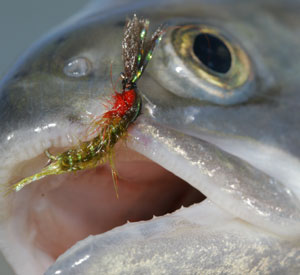The Midge
Midges, in one form or another, are present in nearly all stillwaters in the UK and Ireland, if not worldwide. The family that is of particular interest to the trout and, therefore, the angler, is the non-biting midge or Chrionomidae.
The life cycle begins with the female midge laying her eggs on the water’s surface, which sink to the lake bed before (after a couple of weeks) hatching into the larva. Anglers know this red, worm-like beast as a bloodworm. Preferring silty lake beds to live in, the bloodworm, over the next few weeks and depending on warming waters, pupate. This next stage in the cycle is what anglers know as the buzzer or midge pupa. Common colours are varying shades of green, black, brown or orange and they are, without doubt, the bugs most commonly imitated by UK trout anglers.
The pupa ascends to the surface of the water – particularly in mild weather conditions – where its case breaks and the adult midge emerges. It’s at this point that the insect is at its most vunerable to trout, as it often becomes trapped in the surface tension – the emerging midge. Late May through to early July see midges in their millions hatch on our stillwaters both large or small. So, follow this guide and make the most of some truly great fishing!
 |
Black Adult Buzzer
Hook: Curved up-eye buzzer hook
Body: Black pheasant tail fibres
Rib: Stripped peacock herl
Wings: White hackle tips
Thorax cover: Black pheasant tail fibres
Thorax: Fine black dubbing
Hackle: Black hen
Note: Choose colours to suit midges hatching
 |
Terry’s Emerger, Olive
Hook: Curved dry-fly hook
Body: Olive seal’s fur
Thorax: Dark olive seal’s fur
Hackle: Olive grizzle cock
Wing: White calf tail
Note: Choose colours to suit midges hatching
 |
CDC Black Red Butt Shuttlecock
Hook: Medium-shank dry-fly hook
Butt: Red floss
Body: Black pheasant tail fibres
Rib: Fine silver wire
Wing: Natural CDC
Note: Choose colours to suit midges hatching
All of the patterns above can be bought from Fulling Mill: 01293 778600, www.fullingmill.com
Rods
When it comes to surface-feeding trout you need to get the basics right. There’s a time and a place for heavy-handed tactics, but this isn’t it. Powerful 7-wt wands are fine when it comes to throwing lures to the horizon, but when it comes to wary fish feeding close to the surface, heavier rods and lines are best left at home.
A soft-actioned 5-wt model will give better presentation, alighting the fly on the water with a lot less disturbance. Such a rod also helps when playing fish, as you’ll inevitably be using light leaders for presentation purposes. With a stiffer-actioned rod you run the risk of breakages.
Lines
Quite often you’ll hear people banging on about the benefits of drab-coloured floating lines. Well, a bright-orange fly line may not be the best thing in the world to use when fishing a small overgrown brook for wild fish. Something a bit more sombre would be a lot less conspicuous. However, fly-line colour won’t make much of a difference on most stillwaters.
Tapered Leaders And Tippet Material
When fishing a single fly, tapered leaders are most definitely required. The taper allows the transfer of energy from the fly line to the fly. When this occurs, turnover is not a problem, even in a fairly ‘stiffish’ breeze.
Try casting a fly into the wind with a 14ft length of 4lb nylon. More often than not everything will land in a heap. You will try and overcompensate, giving a little extra push on the forward stroke when casting. This is only going to make things worse, and you’re guaranteed to end up with wind knots! So, tapered leaders it is then.
When boat fishing, a single length of leader should do the job. With the wind behind you and by casting a more open loop, the flies ‘should’ land on the water perfectly every time.
Tippets shouldn’t be too heavy. It’s all about flexibility and diameter. Your patterns aren’t going to look right if they are attached to material that resembles towrope.
There seems to be a lot of discussion on the different properties of both fluorocarbon and copolymer. It doesn’t matter, as long as it’s limp, relatively thin and suits fly size and conditions.
Sinkant
The job of sinkant is to degrease the tippet. When handling the tippet, oil from your skin attaches itself to the material. Believe it or not, this is enough to keep it sitting on the surface of the water, which is bad. Make a point of applying the sinkant at least every half a dozen casts. The other benefit of rubbing the tippet with this is the fact that it takes some of the shine off the material.
Location
Midges like nothing better than a nice silty bottom. Find this kind of area on your water and you’ll get fish very close by. The young midges or bloodworm need silt to burrow into. Trout know this and will often patrol these areas. When the midges hatch, the fish can be picked off with a whole manner of dry-fly patterns.
Conditions
If you are lucky enough to get flat-calm conditions during a hatch, giving stronger tension in the surface film, midges will find it harder to hatch. As they struggle to force their way through, they become easy pickings for trout. The fish have a long time to scrutinise your fly, but get everything right and you could have a field day.
This is also the case with wind lanes. A strong breeze may ruffle the majority of the water’s surface but you’ll always get wind lanes and slicks. These oily looking patches of water can be quite small but on some of our major waters they can be hundreds of yards long. Trout will often work their way up these slicks, picking off anything that’s stuck in the surface film.






